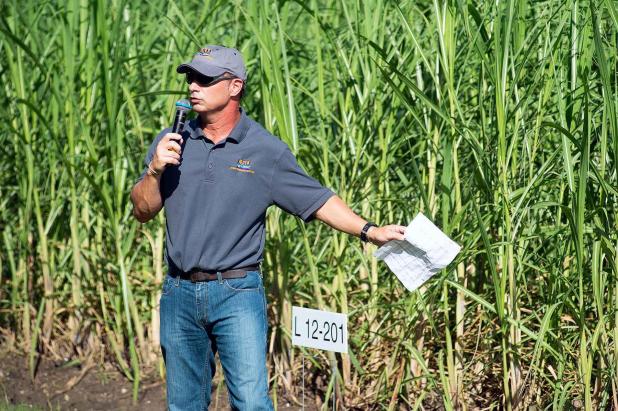
LSU AgCenter/Olivia McClure
LSU AgCenter sugar cane breeder Michael Pontif speaks about a new variety at a Wednesday field day in St. Gabriel.
Cane is back on the grow after Barry
ST. GABRIEL — After escaping Hurricane Barry with minimal damage, the Louisiana sugar cane crop seems to be on track for another successful harvest.
Barry, a Category 1 hurricane that made landfall July 13 near Vermilion Bay, delivered anywhere from 3 to 14 inches of rain across the sugar cane belt in south Louisiana.
“We were pretty dry, so actually, people were looking for a little bit of rain,” said LSU AgCenter sugar cane specialist Kenneth Gravois.
While some cane in coastal areas remains under water that was pushed in by tidal surge, that water does not appear to be salty, and “we are hopeful that the problem is localized and not industry-wide,” he said. And because this year’s crop is a little shorter than usual, lodging and top breakage from storm winds were limited.
“It’s early in the tropical season, and we have a long way to go, but we dodged a major bullet,” Gravois said. “We do have some issues to deal with, but we think that with good weather, the crop will upright itself.”
Before the hurricane, 2019 sugar production was projected to hit 1.8 million tons — just under the 1.82 million-ton record set in 2017.
“We think that 1.8 million tons is still very attainable,” Gravois said.
He expects mills to open for processing around Sept. 17 — an early start date that is necessary because this year’s crop is large.
Gravois said the sugar cane belt has expanded by 10,000 to 12,000 acres, primarily on its western and northern fringes. Last year, total acreage in Louisiana was 459,217.
Good prices are drawing more people into the sugar cane business.
“The suspension agreements that are in place right now have really stabilized the market,” Gravois said, referring to measures implemented to prevent Mexico from “dumping” sugar in the U.S. “Sugarcane is also a very resilient crop, so it can take these weather conditions. We don’t see a lot of fluctuations in our yields compared to other crops.”
Farmers also are reaping the benefits of productive, sturdy sugar cane varieties developed through cooperative efforts of the AgCenter, U.S. Department of Agriculture and American Sugar Cane League.
At a Wednesday field day at the AgCenter Sugar Research Station in St. Gabriel, scientists announced two new varieties have been approved for commercial release: L 12-201 and Ho 12-615. Both have high sugar yield — a main objective of the breeding program.
Currently, an older variety called L 01-299 accounts for about half of Louisiana sugarcane acreage. “Anytime we get new varieties that allow us to diversify our variety mix” is cause for excitement, Gravois said.
“There’s an advantage to having varieties with different characteristics and different strengths on your farm,” explained AgCenter sugarcane breeder Michael Pontif.
A farm planted with just one variety could be wiped out if stricken by a disease or insect the variety cannot tolerate, Pontif said. That would lead to a major profit loss.
It takes about 12 years to develop a new sugarcane variety.
“It’s a long process,” Pontif said, that begins with single plants being selected for desirable traits. Years later, prospective varieties are planted in 12 locations to test how they stand up to various conditions.
“Once they make it that far, that’s really the telltale sign that they’re going to be able to make it through and become a commercial variety,” Pontif said.
